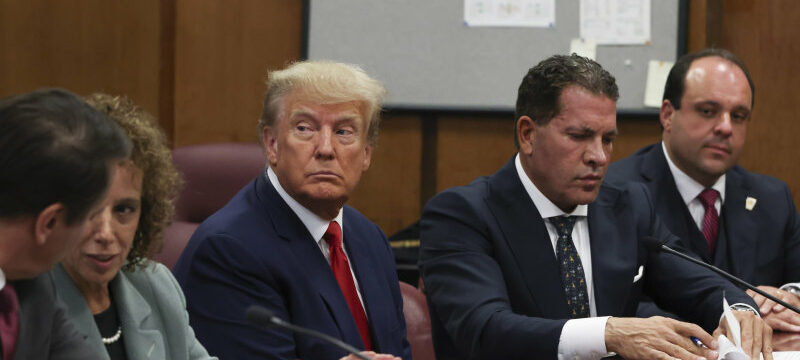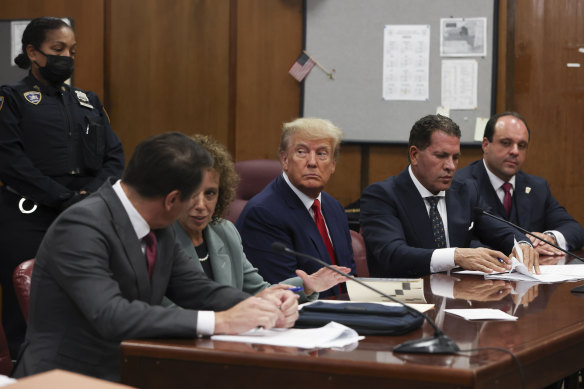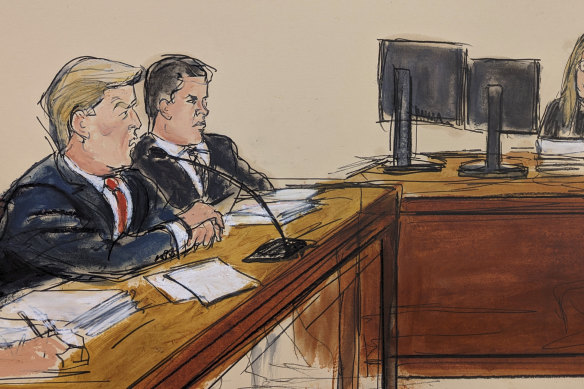New York: The first-ever arraignment of a former US president played out behind closed doors last week, walled off from the sea of television cameras and microphones outside.
Journalists who made it inside the Lower Manhattan courtroom where prosecutors detailed the criminal charges against Donald Trump were free to scribble quotes and observations in their notebooks. But beyond their accounts, the only publicly available record of the proceeding – an event with sprawling political consequences and no parallel in American history – is a 32-page court transcript and drawings from three courtroom sketch artists. (New York Supreme Court Justice Juan Merchan permitted five still news photographers to document the scene, but they were dismissed before the arraignment began.)
Donald Trump appears in court on Tuesday for his arraignment on charges related to falsifying business records.Credit: AP
In total, Trump uttered just 10 words during the hour-long hearing.
Most were one or two-word responses to procedural questions from the judge. Together, they read almost like a haiku – a stark contrast with the rambling speeches, combative interviews and strongman’s bluster that have long defined Trump’s political persona.
When the former president did speak, he said only what he needed to say. His tone was morose, almost sour. He sat hunched in his seat, occasionally listening to whispers from his attorneys. He made almost no facial expressions.
The hearing began as any other criminal hearing would. The clerk of court called up “Indictment 71543, People of the State of New York v Donald J. Trump”. After the prosecutors and defence attorneys announced themselves, Merchan got straight to the point.
Donald Trump, far left, pleading “not guilty” after the Clerk of the Court read the charges and asked him “How do you plea?” Credit: Elizabeth Williams via AP
“Let’s arraign Mr Trump,” the judge said, according to the transcript.
The felony charges were 34 counts of falsifying business records in the first degree. “How do you plead to this indictment,” Merchan asked, “guilty or not guilty?”
“Not guilty,” said Trump, dressed in a navy-blue suit and bright red tie.
Trump sat quietly between his four lawyers and listened as prosecutors presented their case, which centres on his role in paying and covering up the payments to adult-film star Stormy Daniels and two other people to keep quiet about alleged sexual encounters to protect his presidential campaign.
After outlining the charges, prosecutors turned their attention to Trump’s recent remarks about the case. Before he was indicted, he warned that his arrest could bring “death & destruction”, and he later lashed out at Merchan and District Attorney Alvin Bragg, claiming they were biased against him.
Assistant District Attorney Christopher Conroy asked the judge to impose a protective order to prevent Trump from posting sensitive information produced during the discovery phase of the case.
Trump defence lawyers Todd Blanche took issue with the prosecutor’s focus on Trump’s rhetoric. He acknowledged that Trump had “responded, and responded forcefully” to the allegations but said his words didn’t amount to threats or harassment.
“It is true that as part of that response, he’s absolutely frustrated, upset and believes that there is a grave injustice happening with him being in this courtroom today,” Blanche told the judge.
“He has rights,” Blanche added, “he’s allowed to speak publicly.”
The judge said he was unconvinced that Trump’s language was “just by frustration”. He said the defence team should tell Trump to “refrain from making statements that are likely to incite violence or civil unrest”. He told prosecutors to do the same with their witnesses.
After a lengthy discussion on the next steps in the case, the parties debated whether one of Trump’s lawyers, the brash and outspoken Joe Tacopina, had a conflict of interest in representing him.
Prosecutors said Tacopina should be conflicted out because Daniels – a witness in the case – once contacted Tacopina about potentially hiring him. Tacopina said no conflict existed because, among other reasons, he had refused her case.
The judge turned to Trump and told him that while he wasn’t making any findings of fact, he wanted him to know that he had an “absolute right to conflict-free representation”.
“Do you understand that right, Mr Trump?” Merchan asked.
“Yes,” Trump said.
Merchan continued, saying that Trump, for the time being, was free to “consult with other counsel, run this issue by them and see how you feel about it when it’s over, okay?”
“Okay, thank you,” Trump responded.
From there, the judge read Trump a series of Parker warnings, which inform criminal defendants that it’s in their best interest to be present at every stage of their case.
Merchan noted that he had the authority to proceed without Trump if he chose not to appear.
“Do you understand that?” he asked.
“Yes,” Trump said.
The judge also warned that he could remove Trump from court if he became “disruptive” to the point that it affected the judge’s ability to preside over the case. Did he understand that?
“I do,” Trump responded.
Finally, Merchan noted that trial, verdict and sentencing could all proceed in Trump’s absence if Trump was removed or waived his right to appear.
“Do you understand?” the judge asked again.
Trump, stone-faced, gave his last answer.
“Yes.”
The Washington Post
Most Viewed in World
From our partners
Source: Read Full Article


